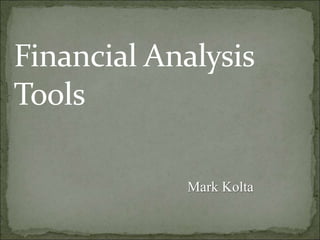
Financial Analysis Tools - Mark Kolta
- 1. Mark Kolta
- 2. The application of analytical tools and techniques to financial statement data. Allows users to focus on how numbers are related and how they have changed over time
- 3. External users rely on general purpose financial statements Make predictions about an organization as an aid in making decisions Users highlight important trends or changes
- 4. Users try to balance the risk of an investment with its expected return Generally the greater the risk, the higher the return Financial statement analysis is one source of information for assessing risk and return
- 5. Public companies must publish an annual financial report Government reports SEC 10K, 10Q Financial service information Moody’s, Dow-Jones Financial newspapers and periodicals Wall Street Journal
- 6. Horizontal analysis Vertical analysis Ratio analysis
- 7. Amount of change = later year amount - Earlier year amount Percentage change = Amount of change / Earlier year amount Look for significant change
- 8. Set all amounts in base year at 100% Compute percentages for a number of years Divide each statement amount by respective amount in base year Shows degree of increase or decrease in individual statement items Used to explain changes in operating performance
- 9. Shows how each item in a financial statement compares to the total of that statement Balance sheet Set both total assets and total equities at 100% Income statement Set net sales at 100%
- 10. Identify significant dollar and percentage changes Explain the changes Identify whether they are favorable of unfavorable
- 11. Shows the relative size of one financial statement component to another. Effective only when used in combination with other ratios, analysis, and information.
- 12. Short-term liquidity Long-term solvency Profitability Market performance
- 13. Current ratio Quick ratio Accounts receivable turnover Days’ sales in receivables Inventory turnover
- 14. Common measure of liquidity Ability to pay debts as they come due Rule of thumb 2:1 Consider other factors Current Assets Current Liabilities
- 15. More strict measure of short-term liquidity Numerator includes only quick current assets Assets readily converted to cash Cash + Short-term investments + Net Current Receivables Current liabilities
- 16. How many times we turn accounts receivable into cash during a period Net sales Average net accounts receivable
- 17. How many days’ sales remain uncollected in accounts receivable Net sales per day = Net sales 365 days Average net accounts receivable Net sales per day
- 18. Number of times the company sells and replaces its inventory during the period Holding inventory results in financing and storage costs Cost of goods sold Average inventory
- 19. Debt ratio Times Interest Earned
- 20. Shows amount of total assets creditors provide Higher levels of debt financing means company has a higher risk of not meeting interest and principal payments Total liabilities Total assets
- 21. Number of times the company earned interest expense with current income Creditors want to know the firm’s ability to pay annual interest charges Net income + Income tax expense + Interest expense Interest expense
- 22. Profit margin Total asset turnover Return on total assets Return on owners’ equity Earning per share
- 23. Percentage each sales dollar contributes to net income Net income Net sales
- 24. Measures the efficiency of the company is using its investment in assets to generate sales Net sales Average total assets
- 25. Measures the amount a company earns on each dollar of investment in assets Net income Average total assets
- 26. Measures the earnings in relation to the owners’ investment in the company Net income - Preferred dividends Average owner’s equity
- 27. Measures the net income available to each share of common stock Discussed in depth in Chapter 14 Net income - Preferred dividends Weighted average number of common shares outstanding during the year
- 28. Price/Earnings (P/E) ratio Dividend yield
- 29. Number of times earnings per share the stock is currently selling for in the market Market price per share of common stock Earnings per share
- 30. Measure of dividend-paying performance of a company Investors buy stock for two reasons Receive cash dividends Sell stock at a higher price Dividends per share Market price per share
- 31. Historical nature of accounting information Changing economic conditions Comparisons with industry averages Seasonal factors Quality of reported income
- 32. Thanks
